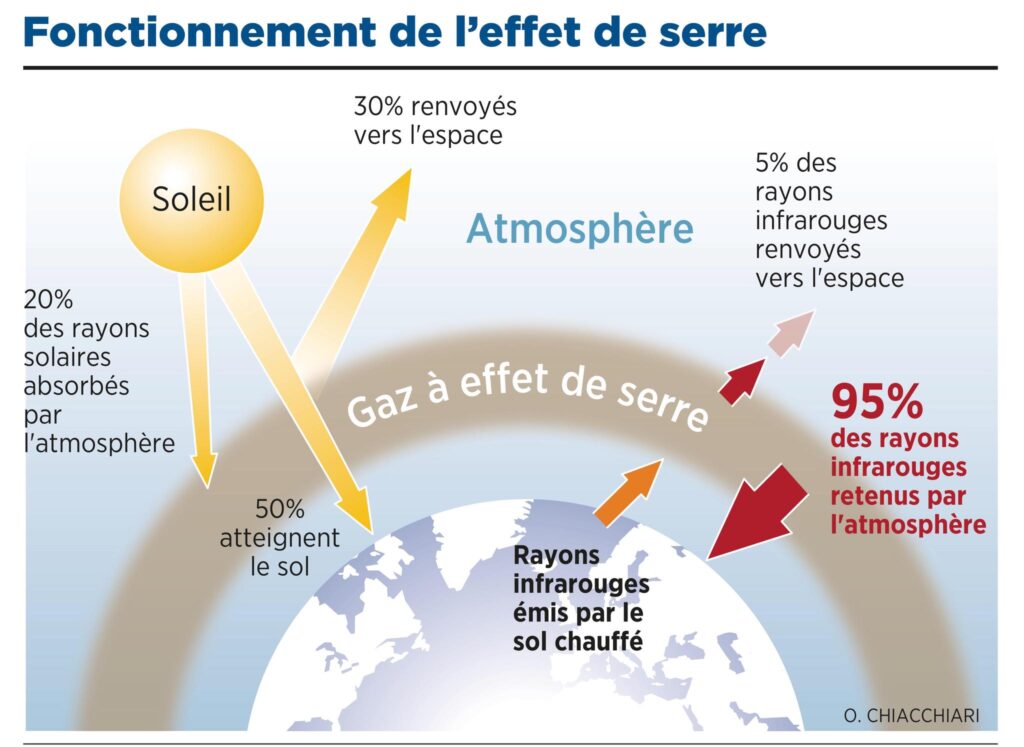The greenhouse effect is a natural phenomenon that plays a crucial role in regulating the temperature of our planet. It occurs due to certain gases that make up our atmosphere, allowing the Earth to retain the heat from the sun. Without this essential process, the average temperature of our planet would be much lower, making life as we know it impossible. It is thanks to the greenhouse effect that our flowers bloom and our atmosphere maintains a pleasant temperature of +15 °C instead of -18 °C. However, human activities have disrupted this fragile balance, increasing the concentration of greenhouse gases and contributing to global warming. Understanding this phenomenon is therefore essential to grasp our environmental impact and explore solutions for a more sustainable future.
The greenhouse effect is an essential natural phenomenon that plays a crucial role in regulating the temperature of our planet. Without it, the Earth would have an average temperature of -18 °C, making life as we know it impossible. Thanks to this effect, the average temperature on Earth remains around 15 °C, allowing for the development of biodiversity.
It works through a process of energy exchange between the sun and the Earth. When sunlight reaches the Earth’s surface, it is partially absorbed by the ground and the sea and transformed into infrared radiation. This radiation, being a form of heat, is partly sent back into space. However, a significant proportion is captured by greenhouse gases present in the atmosphere.
Among these gases, water vapor is the most abundant and plays a major role in the process. Other important gases include carbon dioxide (CO₂), methane (CH₄), and nitrous oxide (N₂O). They have the ability to trap heat, which leads to an increase in air temperature by acting as an insulating blanket around the planet. This creates the conditions favorable for life on Earth.
The problem arises when the concentrations of these gases increase excessively due to human activities, such as the combustion of fossil fuels, deforestation, and industrial agriculture. This increase amplifies the greenhouse effect, leading to global warming. To understand how this works, it is crucial to note that record levels of pollutants are alarmingly warming the planet in 2023 (learn more).
To mitigate these impacts, many initiatives focus on adopting renewable energies such as wind and solar energy. For example, some eco-responsible companies are innovating with wind energy to reduce their carbon footprint (see here). These efforts aim not only to decrease the concentration of greenhouse gases but also to promote a sustainable future.
Moreover, technology plays a vital role in mastering the greenhouse effect. Greentech technologies are redefining the future of the sustainable industry by offering innovative solutions to minimize environmental impact (more details).
Ultimately, understanding the greenhouse effect and its implications for our climate is essential to develop effective strategies for protecting our environment. This involves transitioning to cleaner energy sources and significantly reducing greenhouse gas emissions. To go further in this effort, it is relevant to learn about how tidal power plants and other innovations can contribute to this transition (explore here).

FAQ on the Greenhouse Effect
Q : What is the greenhouse effect?
A : The greenhouse effect is a natural phenomenon whereby certain gases in the atmosphere, such as water vapor, retain a portion of the heat emitted by the Earth’s surface. This helps maintain an average temperature of 15°C at the Earth’s surface.
Q : What are the most common greenhouse gases?
A : The most common greenhouse gases include water vapor, carbon dioxide (CO2), methane (CH4), and nitrous oxide (N2O).
Q : Why is the greenhouse effect essential for life on Earth?
A : The greenhouse effect is essential for life on Earth because, without it, the average temperature would be around -18°C, making the planet inhospitable for most life forms.
Q : What are the consequences of increasing the greenhouse effect?
A : The increase in the greenhouse effect due to human activities leads to global warming, causing climate disruptions, glacier melting, and rising sea levels.
Q : What can be done to reduce greenhouse gas emissions?
A : To reduce emissions of greenhouse gases, it is important to promote the use of renewable energies, improve energy efficiency, encourage recycling, and promote sustainable transportation methods.
Articles similaires
Thank you!
We will contact you soon.













